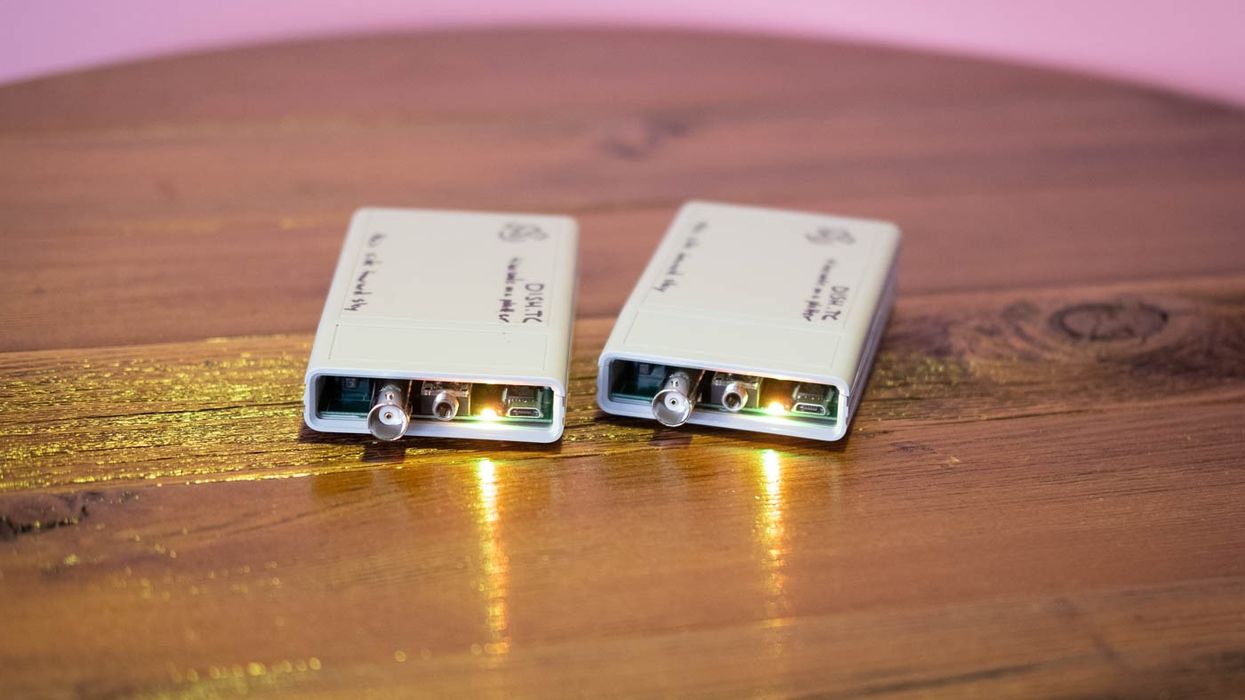Dish.TC Makes Timecode Sync Dead Simple on Set
Dish.TC uses GPS satellites to keep your footage in sync. We tested it and it really is as simple as it seems.

The promise of Dish.TC is an intriguing one: single plugin in, "set it and forget it" timecode sync. Just make sure the device is getting its signal, plug it into the audio input on your camera, and go. Since most timecode sync involves jamming together the recorder and the camera and constantly re-jamming (though some cameras can still have drift), this no-drift promise is intriguing. While we covered the launch of the Kickstarter a few weeks ago, we also wanted to get a little hands-on time with a unit. Dish.TC nicely let us play with one for a few weeks.
The Build
First off, the demo units we tested, while the same units tested by professionals out the in field, are an earlier design that has already been revised, mostly for the better. The release units seen in the Kickstarter video are clearly smaller, and no longer have an SDI port. Their USB port is internal and protected by the battery cover. There is just that 3.5mm audio jacket, and a scratch microphone, and now a 1/4-20 threaded mount for attaching it securely. The underlying technology hasn't changed.
Technology
What is that underlying technology? Basically, for GPS systems to work they need to distribute very, very accurate time so that devices that are trying to figure out where they are can properly triangulate satellite signals. Since GPS satellites are constantly sending out this signal, and all of our phones receive it to help us navigate, the thought was, why not use that for timecode? Get the most accurate time you can, stick it into the device, and then pipe it into the camera.
Dish.TC does a good job of warning you on their website that you might not get GPS signal in some locations, like missile bunkers and mines, but it might be more than that. For instance, I tried to get a signal in an old Navy communications building and couldn't. There are giant antennae on the roof, possibly that were blocking the signal, but I had to walk outside to sync. Once I did so, however, the lights changed from red to green (then blinking green), and we were off to the races. Plug it in the camera and the zoom recorder and away we go.
The method for piping it into the camera is both wonderful and the biggest frustration. Linear Timecode, or LTC, is a longstanding format for recording timecode to the audio track. It's not some new standard Dish.TC is creating; it exists out there in the world and Dish.TC is just taking their GPS time information and plugging it into that format.
Most major applications should support it, and with Resolve, it was a single click and the clips timecode changes from what the camera recorded to what the Dish.TC was putting out. Super cool.
Post Workflow
However, the post workflow is where we still had issues. Resolve won't do the same trick to audio files, though apparently there is a workaround where you take each wave file and attach it to a video clip and then render it out and bring it back in and do the extraction, which seems like too much work. Premiere won't extract from LTC at all. Media Composer, of course, handles it all just fine, but that's just the kind of thing Media Composer would do.
Dish.tc is working on an application to make the process of extracting LTC and changing timecode in the files simple, and that will help a ton. It's currently available as a pre-release as development continues.
The Future
What's interesting as well is wondering about the future of the company.
Honestly, this is one of those ideas that has us wondering why every camera doesn't just have this built in. Even with sync likely moving to Bluetooth in the future, why not also have GPS time in the camera and audio recorder too? Hopefully, Dish.TC has figured out some secret sauce so that major manufacturers will work with them as they integrate GPS timecode into their devices. Or perhaps one of the major manufacturers will acquire the company for their tech. (Sony or Panasonic, with their robust ENG and live event markets, seem like great fits.)
Now that the idea is out there and working, it seems like it will quickly be something that starts showing up in other cameras. If nothing else, I think we can assume Blackmagic, always willing to put everything in their cameras, will have a version of it internally in the next few years.
Overall, we were impressed with just how simple it made things on set. You need to test your workflow in post and hopefully, the software Dish.TC is working on will make that workflow easier. With proper testing, this should be really useful for a lot of productions.
Tech Specs
- Locking 3.5mm connectors
- 1/4-20 threaded mounting point
- scratch microphone
- AA power
- Micro-USB connector
Check out the Dish.TC Kickstarer campaign for more info.














